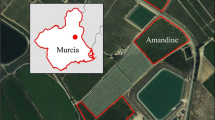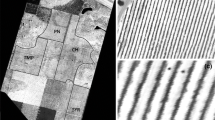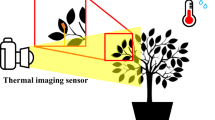Abstract
Thermal imaging of crop canopies has been proposed more than a decade ago as a sensitive methodology to determine the water status of different crops. This paper describes the development of a semi-automated and automated methodology using MATLAB® programming techniques to analyse the infrared thermal images taking into consideration the pitfalls pointed out previously in the literature. The proposed method was tested in an irrigation reduction and recovery trial for Chardonnay in the 2010–2011 season and in the 2009–2010 season from seven varieties in field conditions. There was a clear separation (assessed by principal component analysis) between control and recovery compared to stress treatments using leaf area index (LAI), stomatal conductance, stem water potential and indices derived from canopy temperatures measured by infrared imaging. High and significant correlations were found between canopy temperature indices and other measures of water stress obtained in the same vines that were independent of LAI. Furthermore, a fully automated analysis method has been proposed using ancillary weather information obtained from the same locations of infrared thermal images. This paper is a first step towards automation of infrared thermography acquisition and analysis in the field for grapevines and other crops.







Similar content being viewed by others
References
Acevedo-Opazo C, Ortega-Farias S, Fuentes S (2010) Effects of grapevine (Vitis vinifera L.) water status on water consumption, vegetative growth and grape quality: an irrigation scheduling application to achieve regulated deficit irrigation. Agric Water Manag 97(7):956–964
Chone X, Van Leeuwen C, Dubourdieu D, Gaudillere J-P (2001) Stem water potential is a sensitive indicator of grapevine water status. Ann Bot 87:477–483
Cifre J, Bota J, Escalona JM, Medrano H, Flexas J (2005) Physiological tools for irrigation scheduling in grapevine (Vitis vinifera L.): an open gate to improve water-use efficiency? Agric Ecosyst Environ 106(2/3):159–170
Cohen Y, Alchanatis V, Meron M, Saranga Y, Tsipris J (2005) Estimation of leaf water potential by thermal imagery and spatial analysis. J Exp Bot 56(417):1843–1852
Collins MJ, Fuentes S, Barlow EWR (2009) Partial rootzone drying and deficit irrigation increase stomatal sensitivity to vapour pressure deficit in anisohydric grapevines. Funct Plant Biol, in press
De Bei R, Cozzolino D, Sullivan W, Cynkar W, Fuentes S, Dambergs R, Pech J, Tyerman S (2011) Non-destructive measurement of grapevine water potential using near infrared spectroscopy. Aust J Grape Wine Res 17(1):62–71
Ferrini F, Mattii GB, Nicese FP (1995) Effect of temperature on key physiological responses of grapevine leaf. Am J Enol Vitic 46(3):375–379
Flexas J, Bota J, Escalona JM, Sampol B, Medrano H (2002) Effects of drought on photosynthesis in grapevines under field conditions: an evaluation of stomatal and mesophyll limitations. Funct Plant Biol 29(4):461–471
Fuentes S, Collins M, Rogers G, Kelley G, Conroy J (2005) Use of infrared thermography to assess spatial and temporal variability of stomatal conductance of grapevines under partial root zone drying: an irrigation scheduling application. Acta Hortic 689:309–316
Fuentes S, Palmer AR, Taylor D, Zeppel M, Whitley R, Eamus D (2008) An automated procedure for estimating the leaf area index (LAI) of woodland ecosystems using digital imagery, MATLAB programming and its application to an examination of the relationship between remotely sensed and field measurements of LAI. Funct Plant Biol 35(10):1070–1079
Grant OM, Tronina L, Jones HG, Chaves MM (2007) Exploring thermal imaging variables for the detection of stress responses in grapevine under different irrigation regimes. J Exp Bot 58(4):815–825
Guilioni L, Jones HG, Leinonen I, Lhomme JP (2008) On the relationships between stomatal resistance and leaf temperatures in thermography. Agric For Meteorol 148(11):1908–1912
Idso SB (1982) Non-water-stressed baselines: a key to measuring and interpreting plant water stress. Agric Meteorol 27(1–2):59–70
Jones HG (1992) Plants and microclimate: a quantitative approach to environmental plant physiology. Cambridge University Press, Cambridge
Jones HG (1999a) Use of infra red thermometry for estimation of stomatal conductance as a possible aid to irrigation scheduling. Agric Forest Meterol 95:139–149
Jones HG (1999b) Use of thermography for quantitative studies of spatial and temporal variation of stomatal conductance over leaf surfaces. Plant, Cell Environ 22:1043–1055
Jones HG (2004) Irrigation scheduling: advantages and pitfalls of plant-based methods. J Exp Bot 55(407):2427–2436
Jones HG, Vaughan RA (2010) Remote sensing of vegetation. Principles, practices and applications. Oxford University Press, New York, p 353
Jones HG, Stoll M, Santos T, de Sousa C, Chaves MM, Grant OM (2002) Use of infrared thermography for monitoring stomatal closure in the field: application to grapevine. J Exp Bot 53(378):2249–2260
Leinonen I, Jones HG (2004) Combining thermal and visible imagery for estimating canopy temperature and identifying plant stress. J Exp Bot 55(401):1423–1431
Leinonen I, Grant OM, Tagliavia CPP, Chaves MM, Jones HG (2006) Estimating stomatal conductance with thermal imagery. Plant, Cell Environ 29(8):1508–1518
Lindenthal M, Steiner U, Dehne H-W, Oerke E-C (2005) Effect of downy mildew development on transpiration of cucumber leaves visualized by digital infrared thermography. Phytopathology 95(3):233–240
Lu P, Yunusa IAM, Walker RR, Muller WJ (2003) Regulation of canopy conductance and transpiration and their modelling in irrigated grapevines. Funct Plant Biol 30(6):689–698
Moller M, Alchanatis V, Cohen Y, Meron M, Tsipris J, Naor A, Ostrovsky V, Sprintsin M, Cohen S (2007) Use of thermal and visible imagery for estimating crop water status of irrigated grapevine. J Exp Bot 58(4):827–838
Stoll M, Schultz H, Baecker G, Berkelmann-Loehnertz B (2008a) Early pathogen detection under different water status and the assessment of spray application in vineyards through the use of thermal imagery. Precision Agric 9(6):407–417
Stoll M, Schultz HR, Berkelmann-Loehnertz B (2008b) Exploring the sensitivity of thermal imaging for Plasmopara viticola pathogen detection in grapevines under different water status. Funct Plant Biol 35(4):281–288
Stoll M, Schultz HR, Berkelmann-Loehnertz B (2008c) Thermal sensitivity of grapevine leaves affected by Plasmopora viticola and water stress. Vitis 2:133–134
Tanner CB (1963) Plant temperatures. Agron J 55:210–211
Wang X, Yang W, Wheaton A, Cooley N, Moran B (2010) Automated canopy temperature estimation via infrared thermography: a first step towards automated plant water stress monitoring. Comput Electron Agric 73(1):74–83
Acknowledgments
This project is supported by Australia’s grape growers and winemakers through their investment body the Grape and Wine Research and Development Corporation, with matching funds from the Australian Government. The four organisations, involved in this research project, UoA, CSIRO, SARDI, AWRI, are all part of the Wine Innovation Cluster (www.wineinnovationcluster.com). This project is being undertaken on a collaborative basis by the parties. The authors thank staff from Yalumba Nurseries whose in-kind contributions have included irrigation supplies, irrigation system conversion and management of the vineyard, staff from the Irrigated Crop Management Service (ICMS) who designed the irrigation system conversion and have provided ongoing irrigation system advice, staff at Measurement Engineering Australia (MEA) for in-kind contribution of field monitoring equipment.
Author information
Authors and Affiliations
Corresponding author
Additional information
Communicated by E. Fereres.
Rights and permissions
About this article
Cite this article
Fuentes, S., De Bei, R., Pech, J. et al. Computational water stress indices obtained from thermal image analysis of grapevine canopies. Irrig Sci 30, 523–536 (2012). https://doi.org/10.1007/s00271-012-0375-8
Received:
Accepted:
Published:
Issue Date:
DOI: https://doi.org/10.1007/s00271-012-0375-8




